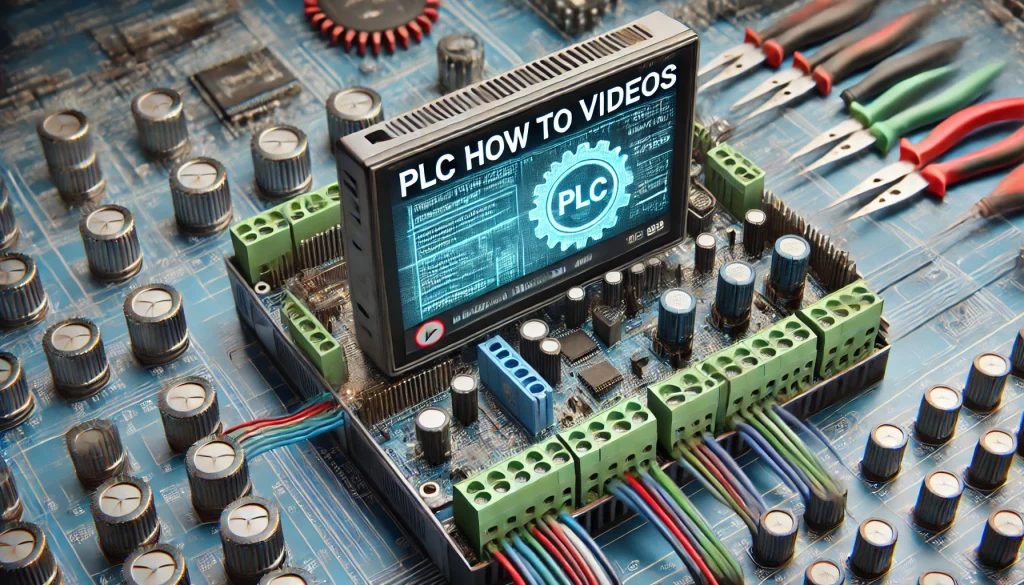PLC How-to Videos – A Comprehensive Guide
In the world of automation, Programmable Logic Controllers (PLCs) are the backbone of many industrial processes. PLCs control machinery on factory floors, manage assembly lines, and ensure that complex systems run smoothly. However, for those unfamiliar with PLCs or those looking to learn new tricks, how-to videos are an excellent way to get up to speed. Whether you’re a beginner looking for an introduction or an experienced technician wanting to refine your skills, PLC how-to videos are a valuable resource.
This article will provide an overview of some key PLC how-to videos and what you can expect from each one, guiding you through the core concepts, configurations, and advanced techniques.
-
How to Config GX Simulator and GT Simulator

How to Configure GX Simulator and GT Simulator GX Simulator and GT Simulator are essential Mitsubishi tools for testing and…
-
How to Connect and diagnostics with GX Works3

Connecting and Diagnosing with GX Works3 GX Works3 simplifies the process of setting up, managing, and diagnosing PLCs for Mitsubishi…
-
How to install GX Simulator and GX Developer

How to Install GX Simulator and GT Simulator GX Simulator and GT Simulator are essential Mitsubishi tools for testing and…
-
How to Real time Monitoring with GX LogViewer

Real-Time Monitoring with GX LogViewer GX LogViewer provides a robust solution for real-time monitoring, enabling you to capture and analyze…
Introduction to PLCs
PLCs are specialized computers designed for controlling machines and industrial processes. These controllers are highly reliable and flexible, able to handle a wide range of input/output operations. To get started with PLCs, you need to understand their basic components:
- Input Devices: Sensors, switches, or other devices that send data to the PLC.
- Output Devices: Actuators, motors, and other devices that receive signals from the PLC.
- PLC Processor: The brain of the PLC, where the logic is processed and control signals are generated.
- Programming Interface: The software used to program and configure the PLC.
Types of PLC How-to Videos
1. Introduction to PLC Programming
These videos provide a basic introduction to PLC programming. If you are new to PLCs, understanding how they are programmed is essential. PLC programming languages include:
- Ladder Logic (LD): The most common PLC programming language, resembling electrical relay logic.
- Structured Text (ST): A high-level programming language used for complex algorithms.
- Function Block Diagram (FBD): Used for process control, involving graphical blocks representing functions.
- Instruction List (IL) and Sequential Function Charts (SFC) are also available but are less commonly used.
These how-to videos will help you understand which programming language is best for your application and how to write basic programs for simple control systems.
2. Wiring and Hardware Setup for PLCs
For a PLC system to function properly, wiring and hardware setup are crucial. These videos typically cover:
- Wiring Inputs and Outputs: Properly connecting sensors, switches, motors, and actuators to the PLC.
- Power Supply Setup: Ensuring that your PLC and connected devices have a stable power source.
- I/O Module Configuration: Understanding how to set up and configure input and output modules for the PLC.
This category of how-to videos is ideal for users who are starting to set up their PLC system or need a refresher on hardware connections.
3. Configuring Communication Protocols in PLCs
PLCs often need to communicate with other machines, computers, or supervisory control systems. Videos on this topic will cover how to:
- Set up communication networks: This includes protocols like Ethernet/IP, Modbus, Profibus, and CC-Link.
- Establish PLC to PLC communication: Learn how to make two or more PLCs exchange data over a network.
- Integrate with SCADA systems: Tutorials on linking PLCs to SCADA (Supervisory Control and Data Acquisition) systems for real-time monitoring and control.
Understanding communication protocols is critical if your PLC will be part of a larger automation system.
4. Troubleshooting PLCs
Troubleshooting is an essential skill for anyone working with PLCs. These how-to videos teach:
- Basic troubleshooting steps: How to identify and correct common PLC issues, such as wiring faults, program errors, and module failures.
- Error diagnostics: Using diagnostic tools and indicators on the PLC to detect problems.
- Advanced troubleshooting techniques: Techniques such as using PLC simulators, debugging with software, and accessing historical logs to solve complex problems.
These videos are helpful for technicians and engineers who need to maintain or repair PLC systems.
5. Advanced PLC Programming Techniques
For those with more experience, advanced programming techniques are critical for optimizing systems. These videos will cover:
- Timers, counters, and data handling: Advanced usage of PLC timers and counters, as well as handling large amounts of data.
- PID control: How to use Proportional-Integral-Derivative (PID) control for fine-tuning industrial processes.
- HMI and PLC Integration: Setting up a Human-Machine Interface (HMI) to interact with the PLC for control and monitoring purposes.
- Creating and managing large control systems: Best practices for writing scalable and maintainable code.
Benefits of Watching PLC How-to Videos
- Visual Learning: Videos offer step-by-step instructions that can be easier to follow than written guides, especially for visual learners.
- Practical Demonstrations: Seeing real-world applications helps you understand how to implement theory into practice.
- Self-paced Learning: With videos, you can learn at your own pace and revisit sections as needed.
- Troubleshooting and Problem Solving: Many videos focus on common issues and troubleshooting, allowing you to quickly identify and resolve problems.
Conclusion

PLC how-to videos are an invaluable resource for anyone working with industrial automation. Whether you’re a beginner learning the basics of PLC programming or an experienced technician refining your skills, these videos offer practical and actionable advice for configuring, programming, and troubleshooting PLC systems. Watching these videos will help you gain the knowledge and confidence needed to work with PLCs and ensure smooth operation of automated processes.
